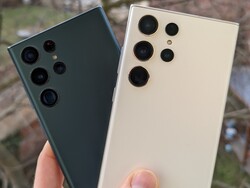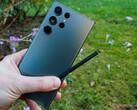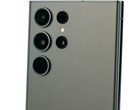Samsung Galaxy S23 Ultra vs. Galaxy S22 Ultra camera review - A noticeable step up...
The Samsung Galaxy S23 Ultra has received numerous improvements to its camera performance over its predecessor, the Galaxy S22 Ultra. Besides having a Qualcomm Snapdragon 8 Gen 2 (instead of an in-house Exynos SoC), the Korean company's latest flagship phone also sports a new 200MP sensor – the ISOCELL HP2.
The HP2 is the successor to the ageing 108MP sensor (ISOCELL HM3) used in the Galaxy S22 Ultra and is only a wee bit larger (1/1.3" compared with the HM3's 1/1.33"). As a result, pixel size has been reduced from 0.8 µm to 0.6 µm. Despite this, Samsung promises better low-light performance and nicer HDR effects.
And this raises the question: can Samsung's 2023 flagship deliver visibly better image quality than its predecessor? In this review, we'll make use of various subjects and lighting situations to analyse the cameras on both Galaxy phones in greater depth and take a look at the different lenses. Having said that, very little has changed in terms of camera specifications other than the new 200MP sensor.
| Samsung Galaxy S22 Ultra | Samsung Galaxy S23 Ultra | |
|---|---|---|
| Camera setup: Rear | 108 MP (f/1.8, 1/1.33", OIS) | 200 MP (f/1.7, OIS, 1/1,3") |
| Telephoto | + 10 MP (f/2.4, 1/3.52", OIS) + 10 MP (f/4.9, OIS) | + 10 MP (f/2.4, 1/3.52", OIS) + 10 MP (f/4.9, OIS) |
| Ultrawide | + 12 MP (f/2.2, 1/2.55") | + 12 MP (f/2.2, 1/2,55″) |
| Camera setup: Front | 40 MP (f/2.2, 0.7 µm) | 12 MP (f/2.2, 1,12 µm) |
| Video capability | 8K24, 4K30, 4K60 | 8K30, 4K30, 4K60 |
| Software version | S9080ZCU2BVL1 | S91BBXXU1AWA6 |
Our test images were captured using Galaxy S22 Ultra with a Qualcomm Snapdragon 8 Gen 1. Comparing it with the European version of the S22 Ultra (which uses Samsung's own Exynos 2200), we did notice some quality differences between the cameras on the two phones, but these differences are so minute that this review also applies to the Exynos variant.
High-resolution main cameras have been a standard feature in the S series for a few years now ever since the release of the Galaxy S20 Ultra. However, the extremely high resolutions are not used by default. Tetra2, Samsung's pixel-binning technology, groups pixels together to increase the effective pixel size, thus allowing more light and information to be captured for an image. Both Galaxy models in this camera comparison utilise this image processing technique, meaning the photos they produce do not necessarily have the same resolution as the camera sensors. You can view the photos taken by us in their original size – simply click on the respective tile in the image comparison section
Images taken with the main cameras

In good lighting conditions, the Galaxy S23 Ultra's image quality is at the same level as what the Galaxy S22 Ultra is capable of, but photos taken with the 2023 flagship sometimes have more details. That said, the Korean giant can go slightly overboard with image sharpening. Looking at the daylight photos, we noticed that images produced by the S23 Ultra are sometimes slightly grainy. This is an area where Samsung still needs to polish up. Which photos you prefer ultimately boils down to a matter of personal taste. One thing we noticed is that focus optimisation is activated much sooner on the Galaxy S23 Ultra (see images of the horse).
There were some smaller issues with focus as well as edge sharpness on photos produced by the 200MP camera at full resolution. We didn't notice this shortcoming when using the 12.5MP pixel-binning mode. Therefore, we can pretty much rule out quality defects with the lenses, and these issues can probably be resolved through software revisions. As you can tell from the photos taken in a room, the new ISOCELL HP2 works better under diffused light than the 108MP sensor in the Galaxy S22 Ultra (see images of the snowman) despite having smaller pixels.
Image comparison
Choose a scene and navigate within the first image. One click changes the position on touchscreens. One click on the zoomed-in image opens the original in a new window. The first image shows the scaled photograph of the test device.
PuppenBuchreiheHausSchneemannPferdIn dark situations, the difference between the two Galaxy phones becomes more apparent. The 200MP photos are considerably more detailed and less noisy than the 108MP photos captured on the S22 Ultra. Logically, this means that the S23 Ultra should also have better image quality in the 12.5MP pixel-binning mode. As a matter of fact, images from the new Samsung flagship are somewhat sharper and more well lit. Considering we are using pre-release camera software in this review, there is likely still a lot of untapped potential in the ISOCELL HP2.
Ultrawide cameras
In daylight, the ultrawide camera on the Galaxy S23 Ultra takes sharper photos than its S22 Ultra counterpart. Although the differences aren't dramatic, edges appear less blurry on ultrawide images from the S23 Ultra. By contrast, the quality differences become more obvious when you compare ultrawide photos taken in dark environments.
The Galaxy S23 Ultra offers more details in our street scene at night. The tree's structures, in particular, look much more natural in the photo taken on the S23 Ultra. Samsung's current flagship also produces more true-to-life colours and is thus better at capturing the atmosphere of a scene. Looking at the festive lighting, you can likewise see that only the S23 Ultra properly captured the red colour of the decorative Christmas star. By contrast, the Galaxy S22 Ultra made it look more purplish pink.
Besides wide-angle images, the ultrawide cameras on both Galaxy phones can also be used to shoot macro photos. For objects in very close proximity, the Galaxy S23 produces impressive results with nice basic sharpness and quite a lot of details. By comparison, photos from the Galaxy Ultra S22 look somewhat blurry and out of focus. Samsung's 2023 flagship also managed to better trace a subject's contours, though the photos appear overly sharp.
Image comparison
Choose a scene and navigate within the first image. One click changes the position on touchscreens. One click on the zoomed-in image opens the original in a new window. The first image shows the scaled photograph of the test device.
TasteSchmetterlingZoom quality
While the 12MP ultrawide camera on the Galaxy S23 Ultra has received a minor upgrade from the Sony IMX563 to the newer Sony IMX564, the two 10MP telephoto cameras use the same 1/3.52" Sony IMX754 found in the S22 Ultra. We can't really tell the difference between the two Galaxy phones on this front. Zoom quality is overall extremely similar on both the 3x and 10x lenses – the 2022 model even has a slight edge in this department. On the other hand, image processing works marginally better on the Galaxy S23 Ultra at higher zoom levels (30x, 100x).
Selfie quality
Unlike the main camera, the front camera on the Galaxy S23 Ultra is on paper a downgrade from the previous generation – at least in its megapixel count. Samsung has done away with the 40MP ISOCELL GH1 sensor on the S22 Ultra and given the S23 Ultra a 12MP ISOCELL S5K3LU.
The results, though, point to the new Galaxy flagship having the superior front camera. Selfies taken with the S23 Ultra are less blurry and also have better details. For instance, the Galaxy S22 Ultra noticeably smoothens beard and skin texture more than the S23 Ultra – both in daylight and at sunset.
Image comparison
Choose a scene and navigate within the first image. One click changes the position on touchscreens. One click on the zoomed-in image opens the original in a new window. The first image shows the scaled photograph of the test device.
TageslichtAbendlichtVideo capabilities
The new 200MP sensor also has an edge over its 108MP counterpart in the S22 Ultra when it comes to video capabilities. The S23 Ultra can now record 8K videos at 30 fps rather than just 24 fps. Beside the higher frame rate, video footage we took revealed the Galaxy S23 Ultra has far better image stabilisation than its predecessor. Whilst the S22 Ultra's 8K video option isn't exactly useful in everyday life, the ISOCELL HP2 can certainly produce usable results, at least in good lighting conditions. We also noticed that the field of view is much wider on the S23 Ultra than on the S22 Ultra and that colours are slightly less saturated.
These sometimes dramatic differences at 8K don't appear in UHD videos. The Galaxy S23 Ultra has slightly better stabilisation, but videos recorded with it in daylight have the same level of quality as those shot on the S22 Ultra. That said, the S23 Ultra produces less noisy videos when the scene is more poorly lit. Samsung has unfortunately missed the opportunity to give its current flagship phone an option to record UHD videos at 120 fps.
Verdict of this camera comparison
Samsung has certainly kept their words and delivered on the promise they made at this year's Unpacked event to give the Galaxy S23 Ultra better low-light performance than its predecessor in everyday use. Whilst we think the Galaxy S23 Ultra's image quality is at the same level as that of the S22 Ultra and still has the potential to improve, the 200MP ISOCELL HP2 sensor is already impressive as it is right now in handling darker scenes – even before the phone's official release. It should be possible to significantly enhance the phone's imaging quality through updates, especially with the new generation of sensors.
The Galaxy S23 is the better camera phone overall, but an upgrade from the S22 Ultra is probably not worth it for most people.
Because of shutter lag when capturing 200MP photos, the sensor's full resolution is still pretty much still only reserved for stationary subjects. Despite this, our comparison photos demonstrate that capturing images at this colossal 16,320 x 12,240 resolution may be worth your while compared with the 108MP mode on the Galaxy S22 Ultra, as long as enough light is present. If Samsung optimises the sharpness level a little, the Galaxy S23 Ultra will be capable of taking brilliant photos. But users should snap several photos at once because even the smallest of shakes can lead to subjects becoming blurry.
The ultrawide camera has likewise been noticeably improved. Other than the sensor update, it seems Samsung has made use of their improved AI algorithm in conjunction with the new image signal processing in the Snapdragon 8 Gen 2 to help the Galaxy S23 Ultra retain greater sharpness and details. The S23 Ultra performs better than its predecessor especially in dark scenes.
Price and availability
The Snapdragon version of the Samsung Galaxy S22 Ultra 5G is available from Trading Shenzhen for roughly €1,167/US$1,259. In Germany, the Samsung Galaxy S22 Ultra with the Exynos SoC can be purchased from retailers such as Amazon, Cyberport and notebooksbilliger.de. Samsung's latest flagship is now available from Amazon and will set you back €1,399/US$1,495.













